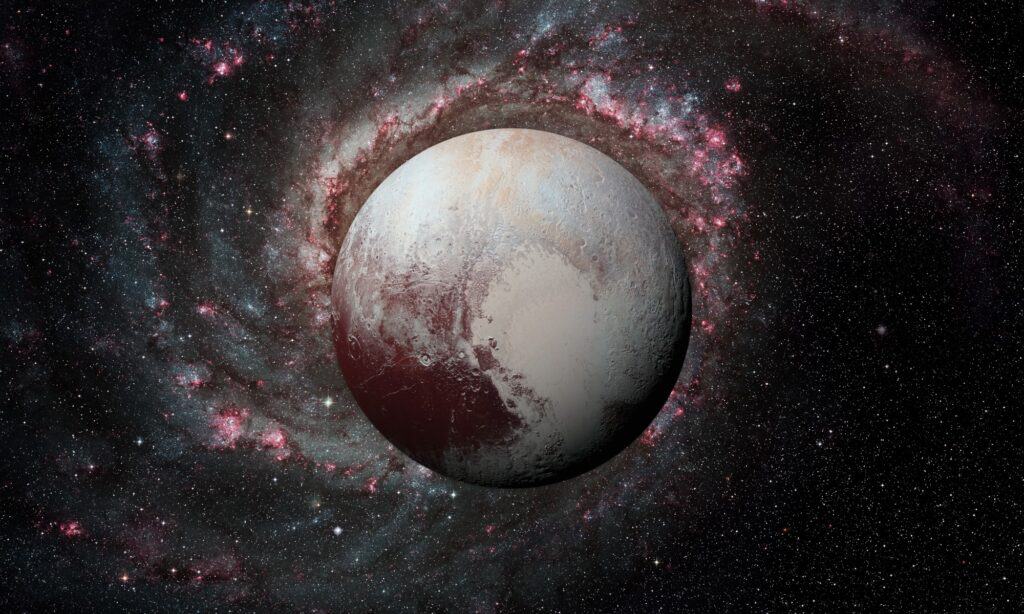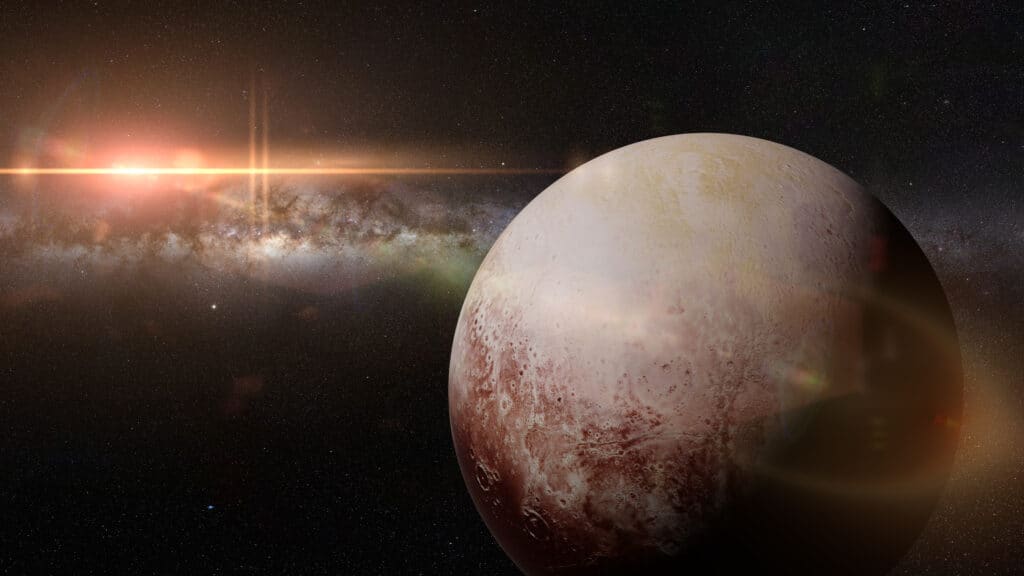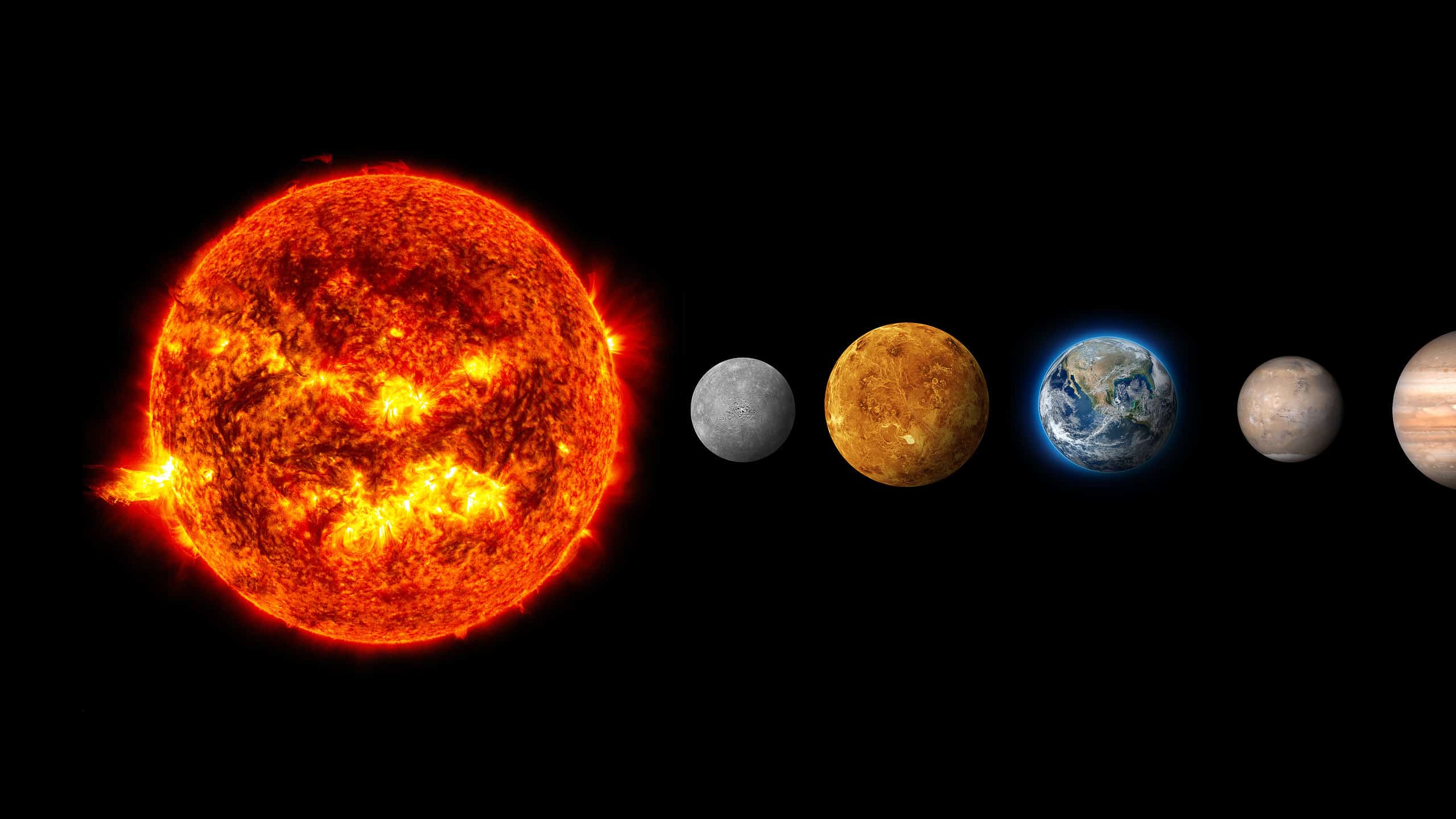Pluto has a fairly contentious history and relationship with humans. In our exploration of space, we got stuck and confused about whether or not Pluto was a planet and where it belonged when we discussed its place in the solar system. Regardless of all of this, Pluto is the ninth-largest and tenth-most massive object to orbit the sun. It is an important part of our solar system, and that means it’s important to know more about it. We’re going to explore the origin of Pluto’s name and get a better look at this dwarf planet.
Pluto’s Geography

Pluto is known as ‘the lost planet’.
©NASA images/Shutterstock.com
Pluto is a dwarf planet in the Kuiper Belt. A dwarf planet differs from a planet mostly in size. The size of a dwarf planet prevents it from having a strong gravitational pull, so it cannot attract all of the material found in its gravitational orbit. There are three criteria to be a planet – a planet must orbit a star, it must have the gravity necessary to form it into a spherical shape, and it must be large enough to clear other objects of similar size from its orbit. Pluto meets two of these three criteria, but cannot clear the space around it of other objects. You can read more about this at the Library of Congress website, which has an extensive informational page on Pluto.
Pluto has a width of about 1,400 miles, which is only about half the width of the United States. Its radius is about 715 miles – 1/6 the size in width of Planet Earth. It sits 3.7 billion miles from the sun and only receives 1/900 of the sunlight Earth does on average. It takes 5.5 hours for sunlight to travel to Pluto. You can experience the maximum amount of sunlight on Pluto at one time of day here on Earth by using NASA’s Pluto Time Calculator.
Pluto has five moons – Charon, Nix, Styx, Kerberos, and Hydra. The dwarf planet’s atmosphere is thin and composed of methane, nitrogen, and carbon monoxide. The planet cannot sustain life – the average temperature is -387 degrees Fahrenheit. Even tardigrades (water bears), who are capable of living in temps as low as -460 degrees Fahrenheit, would struggle to survive those kinds of temperatures long-term.
Pluto is composed of a rich variety of land features. Mountains, valleys, craters, and plains make up the surface of the dwarf planet. Some researchers suspect the presence of glaciers, as well. Researchers also believe Pluto’s crust could be covering a small ocean. While the extreme cold of the surface renders any water rock-like, the interior of the planet seems to be significantly warmer. A lot of mystery surrounds this distant dwarf planet, so some information is hypothetical or theoretical. It is theorized that Pluto’s core is made up of a rocky mantle surrounded by an ice-water ocean.
Pluto’s First Name and Discovery
Pluto was not observed by humans until 1930. American Astronomer Percival Lowell was dedicated to finding planets beyond Neptune. He believed there was something great in the far reaches of space and he was determined to be the one to find it. He called his faith ‘Planet X’, a place no one was sure existed. This Planet X, he believed, was creating strong gravitational pulls that were impacting Neptune and Uranus. He searched for several years, from 1905 to his death in 1916. Unfortunately, he never did find his Planet X.
His work did inspire many other young Astronomers, including Clyde W Tombaugh. Clyde was 23 when he was hired at the Lowell Observatory in Flagstaff, Arizona. It was his job to take detailed and systematic photos along the pathways of the planets in our solar system. This pathway is called the ‘ecliptic.’ This job was painstaking and rigorous, but it was all in the name of a search for the legendary Planet X and the wonders it contained.
This search was actualized in 1930. On February 18th, 1930, Clyde observed an object in space past Neptune, one large enough to potentially be what everyone was looking for. This object was Pluto. Clyde called it Planet X in honor of Percival Lowell until a new name could be chosen. Then, on May 1st, 1930, it was announced that the dwarf planet’s new name was Pluto.
Naming Pluto

Most of our imagery of Pluto is artist impressions based on imagery from various astronomical studies.
©iStock.com/dottedhippo
It didn’t take long to name Pluto. From discovery on February 18th to the selection of the name on March 24th, less than a month passed for the nameless planet. Pluto has, perhaps, one of the most interesting and adorable stories regarding its naming.
Today, the International Astronomical Union is responsible for the naming of new planets, stars, and galaxies in space. However, in 1930, the Observatories who made the discovery got the honor of naming what they had found. Once word got out that a new potential planet had been discovered, the Observatory was flooded with over 1,000 recommendations for a new name. These recommendations included Minerva, Jean, Zyxmal, and Lowellofa.
One March morning in 1930, Venetia Burney, 11 years old, of Oxford, England was eating breakfast with her grandfather. He was reading the paper and remarked on an article talking about the discovery of a new planet. He wondered what it would be called, and Venetia, a youth who was obsessed with Greek and Roman mythology, suggested Pluto. The idea didn’t come from just anywhere – Venetia had many reasons for suggesting the name. She said that since the planet was so cold and far away, it was fitting that it would be named after a Roman God that ruled the cold, dark underworld.
Venetia was not the only person to suggest Pluto as a name, but she was the first. Her grandfather contacted an astronomer with the suggestion, who passed it along until it reached the right ears. Out of hundreds or even thousands of suggestions, young Venetia’s was the favorite. This name also honored Percival Lowell – the first two letters of Pluto are his initials. This is an important honor – without his work and dedication, no one knows when the search might have continued, or from what observatory.
The name ‘Pluto’ was selected on March 24th, 1930, and announced to the public on May 1st of the same year.
Fun Facts About Pluto
- Pluto was classified as a planet until 2006, and its transition to a dwarf planet caused a worldwide stir that still raises contention at family dinner parties.
- The Kuiper Belt, where Pluto makes its home, is shaped distinctly like a donut.
- Pluto is the only other place in our solar system with mountains peaked with white. It shares this honor with Earth.
- Pluto the Dog, a Disney character, was named after the dwarf planet.
- There is a heart shape visible from space on Pluto’s surface.
- Pluto’s orbit around the sun takes 248 Earth years.
- For 20 years of Pluto’s orbit, it draws closer to the sun than Neptune.
- Pluto spins backward – east to west in a constant retrograde.
- Astrologists believe Pluto’s power can unlock and mutate energy and emotions. Many astrologists have a deep reverence for Pluto.
- Charon, the largest of Pluto’s moons, is named after the demon that ferried souls to the underworld. Styx, another moon of Pluto, is named for the river that flows through the underworld.
- Because Charon is so similar in size to its dwarf planet, it is sometimes classified as part of a binary star system. The size similarity creates its own gravitational pull between the two objects, causing some people to refer to the two together as double dwarf planets.
Thank you for reading! Have some feedback for us? Contact the AZ Animals editorial team.








